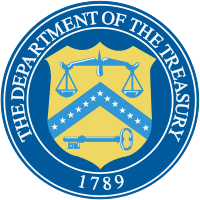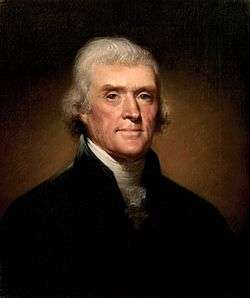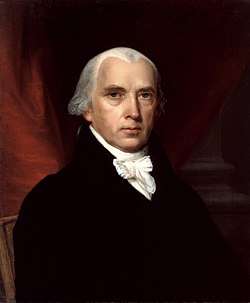Albert Gallatin
Abraham Alfonse Albert Gallatin, born de Gallatin (January 29, 1761 – August 12, 1849) was an American politician, diplomat, ethnologist and linguist. Biographer Nicholas Dungan states he was: "America's Swiss Founding Father."[3] He is known for being the founder of New York University and for serving in the Democratic-Republican Party at various federal elective and appointed positions across four decades. He represented Pennsylvania in the Senate and the House of Representatives before becoming the longest-tenured United States Secretary of the Treasury and serving as a high-ranking diplomat.
Albert Gallatin | |
|---|---|
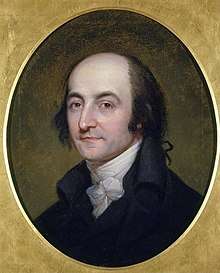 | |
| United States Minister to the United Kingdom | |
| In office September 1, 1826 – October 4, 1827 | |
| President | John Quincy Adams |
| Preceded by | Rufus King |
| Succeeded by | William Beach Lawrence (acting) |
| United States Minister to France | |
| In office July 16, 1816 – May 16, 1823 | |
| President | James Madison James Monroe |
| Preceded by | William H. Crawford |
| Succeeded by | James Brown |
| 4th United States Secretary of the Treasury | |
| In office May 14, 1801 – February 8, 1814* | |
| President | Thomas Jefferson James Madison |
| Preceded by | Samuel Dexter |
| Succeeded by | George W. Campbell |
| Member of the U.S. House of Representatives from Pennsylvania's 12th district | |
| In office March 4, 1795 – March 3, 1801 | |
| Preceded by | William Findley |
| Succeeded by | William Hoge |
| United States senator from Pennsylvania | |
| In office December 2, 1793 – February 28, 1794 | |
| Preceded by | William Maclay |
| Succeeded by | James Ross |
| Personal details | |
| Born | Abraham Alfonse Albert Gallatin January 29, 1761 Geneva, Republic of Geneva (now Switzerland) |
| Died | August 12, 1849 (aged 88) Astoria, New York, U.S. (now New York City) |
| Resting place | Trinity Church Cemetery |
| Political party | Democratic-Republican |
| Spouse(s) | Sophia Allegre (1789–1790) Hannah Nicholson (1793–1849) |
| Education | University of Geneva (BA) |
| Signature | |
| *William Jones served as Acting Secretary from May 9, 1813 – February 8, 1814.[1][2] | |
Gallatin was born in Geneva in present-day Switzerland and spoke French as a first language. He immigrated to the United States in the 1780s, settling in western Pennsylvania. He served as a delegate to the 1789 Pennsylvania constitutional convention and won election to the Pennsylvania General Assembly. An opponent of Alexander Hamilton's economic policies, Gallatin was elected to the United States Senate in 1793. However, he was removed from office on a party-line vote after a protest raised by his opponents suggested he did not meet the required nine years of citizenship. Returning to Pennsylvania, Gallatin helped calm many angry farmers during the Whiskey Rebellion.
Gallatin returned to Congress in 1795 after winning election to the House of Representatives. He became the chief spokesman on financial matters for the Democratic-Republican Party, leading opposition to the Federalist economic program. Gallatin's mastery of public finance led to his choice as Secretary of the Treasury by President Thomas Jefferson, despite Federalist attacks that he was a "foreigner" with a French accent. Under Jefferson and James Madison, Gallatin served as secretary from 1801 until February 1814. Gallatin retained much of Hamilton's financial system, though he also presided over a reduction in the national debt prior to the War of 1812. Gallatin served on the American commission that agreed to the Treaty of Ghent, which ended the War of 1812. In the aftermath of the war, he helped found the Second Bank of the United States.
Declining another term at the Treasury, Gallatin served as Ambassador to France from 1816 to 1823, struggling with scant success to improve relations with the government during the Bourbon Restoration. In the election of 1824, Gallatin was nominated for Vice President by the Democratic-Republican Congressional caucus. Gallatin never wanted the position and was humiliated when forced to withdraw from the race because he lacked popular support. In 1826 and 1827, he served as the ambassador to Britain and negotiated several agreements, such as a ten-year extension of the joint occupation of Oregon Country. He also became president of the National Bank's branch in New York City. In 1842, Gallatin joined with John Russell Bartlett to found the American Ethnological Society. With his studies of the languages of Native Americans, he has been called "the father of American ethnology."
Early life

Gallatin was born on January 29, 1761, in Geneva,[4] and was until 1785 a citizen of the Republic of Geneva.[5] His parents were the wealthy Jean Gallatin and Jean's wife, Sophie Albertine Rollaz.[6] Gallatin's family had great influence in the Republic of Geneva, and many family members held distinguished positions in the magistracy and the military. Jean Gallatin, a prosperous merchant, died in 1765, followed by Sophie in April 1770. Now orphaned, Gallatin was taken into the care of Mademoiselle Pictet, a family friend and distant relative of Gallatin's father. In January 1773, Gallatin was sent to study at the elite Academy of Geneva.[7][8] While attending the academy, Gallatin read deeply in philosophy of Jean-Jacques Rousseau and Voltaire, along with the French Physiocrats; he became dissatisfied with the traditionalism of Geneva. A student of the Enlightenment, he believed in human nature and that when free from social restrictions, it would display noble qualities and greater results, in both the physical and the moral world. The democratic spirit of the United States attracted him and he decided to emigrate.[9]
In April 1780, Gallatin secretly left Geneva with his classmate Henri Serre. Carrying letters of recommendation from eminent Americans (including Benjamin Franklin) that the Gallatin family procured, the young men left France in May, sailing on an American ship, "the Kattie". They reached Cape Ann on July 14 and arrived in Boston the next day, traveling the intervening thirty miles by horseback.[10] Bored with monotonous Bostonian life, Gallatin and Serre set sail with a Swiss female companion to the settlement of Machias, located on the northeastern tip of the Maine frontier. At Machias, Gallatin operated a bartering venture, in which he dealt with a variety of goods and supplies. He enjoyed the simple life and the natural environment surrounding him.[11] Gallatin and Serre returned to Boston in October 1781 after abandoning their bartering venture in Machias. Friends of Pictet, who had learned that Gallatin had traveled to the United States, convinced Harvard College to employ Gallatin as a French tutor.[12]
Gallatin disliked living in New England, instead preferring to become a farmer in the Trans-Appalachian West, which at that point was the frontier of American settlement. He became the interpreter and business partner of a French land speculator, Jean Savary, and traveled throughout various parts of the United States in order to purchase undeveloped Western lands. In 1785, he became an American citizen after he swore allegiance to the state of Virginia.[13] Gallatin inherited a significant sum of money the following year, and he used that money to purchase a 400-acre plot of land in Fayette County, Pennsylvania. He built a stone house named Friendship Hill on the new property. Gallatin co-founded a company designed to attract Swiss settlers to the United States, but the company proved unable to attract many settlers.[14]
Marriage and family
In 1789, Gallatin married Sophie Allègre,[15] the daughter of a Richmond boardinghouse owner, but Allègre died just five months into the marriage.[16] He was in mourning for a number of years and seriously considered returning to Geneva. However, on November 1, 1793, he married Hannah Nicholson, daughter of the well-connected Commodore James Nicholson. They had two sons and four daughters: Catherine, Sophia, Hannah Marie, Frances, James, and Albert Rolaz Gallatin. Catherine, Sophia and Hannah Marie all died as infants. Gallatin's marriage proved to be politically and economically advantageous, as the Nicholsons enjoyed connections in New York, Georgia, and Maryland.[17] With most of his business ventures unsuccessful, Gallatin sold much of his land, excluding Friendship Hill, to Robert Morris; he and his wife would instead live in Philadelphia and other coastal cities for most of the rest of their lives.[18]
Early political career
.jpg)
State legislature and Senate
In 1788, Gallatin was elected as a delegate to a state convention to discuss possible revisions to the United States Constitution.[19] In the next two years, he served as a delegate to a state constitutional convention and won election to the Pennsylvania House of Representatives. As a public official, he aligned with Anti-Federalists and spent much of his time in the state and national capital of Philadelphia. His service on the Ways and Means Committee earned him a strong reputation as an expert in finance and taxation.[20]
Gallatin won election to the Senate in early 1793, and he took his seat in December of that year. He quickly emerged as a prominent opponent of Alexander Hamilton's economic program, but was expelled from the Senate in February 1794 because he had not been a citizen for the required nine years prior to election.[21] The dispute itself had important ramifications. At the time, the Senate held closed sessions. However, with the American Revolution only a decade ended, the senators were leery of anything which might hint that they intended to establish an aristocracy, so they opened up their chamber for the first time for the debate over whether to unseat Gallatin. Soon after, open sessions became standard procedure for the Senate.[22]
Whiskey Rebellion
Gallatin had strongly opposed the 1791 establishment of an excise tax on whiskey, as whiskey trade and production constituted an important part of the Western economy.[23] In 1794, after Gallatin had been expelled from the Senate and returned to Friendship Hill, the Whiskey Rebellion broke out among disgruntled farmers opposed to the federal collection of the whiskey tax. Gallatin did not join in the rebellion, but criticized the military response of the President George Washington's administration as an overreaction.[24] Gallatin helped persuade many of the angered farmers to end the rebellion, urging them to accept that "if any one part of the Union are suffered to oppose by force the determination of the whole, there is an end to government itself and of course to the Union."[25] The rebellion collapsed as the army moved near, and there was no fighting.
House of Representatives
In the aftermath of the Whiskey Rebellion, Gallatin won election to the United States House of Representatives, taking his seat in March 1795.[26] Upon his return to Congress, Gallatin became the leading financial expert of the Democratic-Republican Party. In 1796, Gallatin published A Sketch on the Finances of the United States, which discussed the operations of the Treasury Department and strongly attacked the Federalist Party's financial program.[27] Some historians and biographers believe that Gallatin founded the House Ways and Means and Committee in order to check Hamilton's influence over financial issues, but historian Patrick Furlong argues that Hamilton's Federalist allies were actually responsible for founding the committee.[28] After James Madison declined to seek re-election in 1796, Gallatin emerged as the Democratic-Republican leader in the House of Representatives.[29] During the Quasi-War with France, Gallatin criticized military expenditures and opposed passage of the Alien and Sedition Acts.[30] In the contingent election that decided the outcome of the 1800 presidential election, Gallatin helped Thomas Jefferson secure victory over his ostensible running mate, Aaron Burr.[31]
Secretary of the Treasury
Jefferson administration
.jpg)
Gallatin's mastery of public finance made him the obvious choice as Jefferson's Secretary of the Treasury; as Jefferson put it, Gallatin was "the only man in the United States who understands, through all the labyrinths Hamilton involved it, the precise state of the Treasury." Gallatin received a recess appointment in May 1801 and was confirmed by the Senate in January 1802.[32] Along with Secretary of State Madison and Jefferson himself, Gallatin became one of the three key officials in the Jefferson administration.[33] As Jefferson and Madison spent the majority of the summer months at their respective estates, Gallatin was frequently left to preside over the operations of the federal government.[34] He also acted as a moderating force on Jefferson's speeches and policies, in one case convincing Jefferson to refrain from calling for the abolition of the General Welfare Clause.[35]
With Gallatin taking charge of fiscal policy, the new administration sought to lower taxation (though not import duties), spending, and the national debt; debt reduction in particular had long been a key goal of the party and Gallatin himself.[36] When Gallatin took office in 1801, the national debt stood at $83 million. By 1812, the U.S. national debt had fallen to $45.2 million.[37] Burrows says of Gallatin:
His own fears of personal dependency and his small-shopkeeper's sense of integrity, both reinforced by a strain of radical republican thought that originated in England a century earlier, convinced him that public debts were a nursery of multiple public evils—corruption, legislative impotence, executive tyranny, social inequality, financial speculation, and personal indolence. Not only was it necessary to extinguish the existing debt as rapidly as possible, he argued, but Congress would have to ensure against the accumulation of future debts by more diligently supervising government expenditures.[38]
Shortly after taking office, Gallatin worked with House Ways and Means Committee Chairman John Randolph to reduce federal spending and reduce or abolish all internal taxes, including the tax on whiskey.[39] He presided over dramatic reductions in military spending, particularly for the United States Navy.[40] Despite his opposition to debt, Gallatin strongly supported and arranged the financing for the Louisiana Purchase, in which the U.S. bought French Louisiana. Both Jefferson and Gallatin regarded control of the port of New Orleans, which was ceded in the purchase, as the key to the development of the Western United States. Jefferson had doubts about the constitutionality of the purchase, but Gallatin helped convince the president that a constitutional amendment authorizing the purchase was impractical and unnecessary. Gallatin also championed and helped plan the Lewis and Clark Expedition to explore lands west of the Mississippi River.[41]
Before and after the Louisiana Purchase, Gallatin presided over a major expansion of public land sales. With the goal of selling land directly to settlers rather than to land speculators, Gallatin increased the number of federal land offices from four to eighteen. In 1812, Congress established the General Land Office as part of the Department of Treasury, charging the new office with overseeing public lands.[42] To help develop western lands, Gallatin advocated for internal improvements such as roads and canals, especially those that would connect to territories west of the Appalachian Mountains. In 1805, despite his earlier constitutional reservations, Jefferson announced his support for federally-financed infrastructure projects. Three years later, Gallatin put forward his Report on Roads and Canals, in which he advocated for a $20 million federal infrastructure program. Among his proposals were canals through Cape Cod, the Delmarva Peninsula, and the Great Dismal Swamp, a road stretching from Maine to Georgia, a series of canals connecting the Hudson River with the Great Lakes, and various other canals to connect seaports like Charleston with interior regions. Resistance from many congressional Democratic-Republicans regarding cost, as well as hostilities with Britain, prevented the passage of a major infrastructure bill, but Gallatin did win funding for the construction of the National Road. The National Road linked the town of Cumberland, on the Potomac River, with the town of Wheeling, which sat on the Ohio River.[43] Many of Gallatin's other proposals were eventually carried out years later by state and local governments, as well as private actors.[44]
Throughout much of Jefferson's presidency, France and Britain engaged in the Napoleonic Wars. During Jefferson's second term, both the British and French stepped up efforts to prevent American trade with their respective enemy. Particularly offensive to many Americans was the British practice of impressment, in which the British forced captured American sailors to crew British ships. Jefferson sent James Monroe to Britain to negotiate a renewal and revision of the 1795 Jay Treaty, but Jefferson rejected the treaty that Monroe reached with the British.[45] After the 1807 Chesapeake–Leopard affair, Jefferson proposed, over Gallatin's strong objections, what would become the Embargo Act of 1807. That act forbade all American ships from engaging in almost all foreign trade, and it remained in place until its repeal in the final days of Jefferson's presidency. Despite Gallatin's objection to the embargo, he was tasked with enforcing it against smugglers, who were able to evade the embargo in various ways. The embargo proved ineffective at accomplishing its intended purpose of punishing Britain and France, and it contributed to growing dissent in New England against the Jefferson administration.[46] Overcoming Jefferson's declining popularity and the resentment at the embargo, Secretary of State Madison won the 1808 presidential election.[47]
Madison administration
After taking office, Madison sought to appoint Gallatin as Secretary of State, which was generally seen as the most prestigious cabinet position. Opposition from the Senate convinced Madison to retain Gallatin as Secretary of the Treasury, and Robert Smith instead received the appointment as Secretary of State. Gallatin was deeply displeased by the appointment of Smith, and he was frequently criticized by Smith's brother, Senator Samuel Smith, as well as journalist William Duane of the influential Philadelphia Aurora. He considered resigning from government service, but Madison convinced him to stay on as a key cabinet official and adviser.[48]
In 1810, Gallatin published Report on the Subject of Manufactures, in which he unsuccessfully urged Congress to create a $20 million federal loan program to support fledgling manufacturers.[49] He was also unable to convince Congress to renew the charter of the First Bank of the United States (commonly known as the national bank). Although the national bank had been established as part of Hamilton's economic program, and Jefferson believed that it was "one of the most deadly hostility existing against the principles and form of our Constitution," Gallatin saw the national bank as a key part of the country's financial system. In a letter to Jefferson, Gallatin argued that the bank was indispensable because it served as a place of deposit for government funds, a source of credit, and a regulator of currency. In January 1811, the national bank was effectively abolished after the House and the Senate both defeated bills to recharter the national bank in extremely narrow votes. In response, Gallatin sent a letter to Madison, asking for permission to resign and criticizing the president for various actions, including his failure to take a strong stance on the national bank. Shortly afterwards, Madison replaced Secretary of State Smith with James Monroe, and Gallatin withdrew his resignation request.[50]
Following the repeal of the Embargo Act of 1807, Gallatin was charged with enforcing the Non-Intercourse Act of 1809, which lifted parts of the trade embargo but still prevented American ships from engaging in trade with the British and French empires.[48] In 1811, Congress replaced the Non-Intercourse Act of 1809 with a law known as Macon's Bill Number 2, which authorized the president to restore trade with either France or Britain if either promised to respect American neutrality. As with previous embargo policies pursued by the federal government under Jefferson and Madison, Macon's Bill Number 2 proved to be ineffective at halting the attacks on American shipping.[51] In June 1812, Madison signed a declaration of war against Britain, beginning the War of 1812.[52]
Madison ordered an invasion of Canada by the armies and state militias, but British forces defeated the invasion. The U.S. experienced some successes at sea, but were unable to break a British blockade of the United States. With the abolition of the national bank, the drop in import duties due to the war, and the inability or unwillingness of state banks to furnish credit, Gallatin struggled to fund the war. Reluctantly, he drafted and won passage of several new tax laws, as well as an increase in tariff rates. He also sold U.S. securities to investors, and an infusion of cash from wealthy investors Stephen Girard, John Jacob Astor, and David Parish proved critical to the financing of the war. During the War of 1812, the national debt grew dramatically, going from $45 million in early 1812 to $127 million in January 1816.[53]
Diplomat
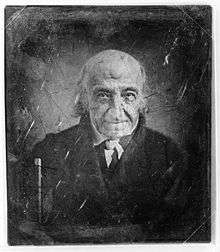
In 1813, President James Madison sent Gallatin to St. Petersburg, Russia to serve as a negotiator for a peace agreement to end the War of 1812. He was one of four American commissioners who would negotiate the treaty, serving alongside Henry Clay, James Bayard, Jonathan Russell, and John Quincy Adams. Efforts at starting negotiations in Russia quickly collapsed. While waiting abroad in the hope of future negotiations, Gallatin was replaced as Secretary of the Treasury by George W. Campbell, with the expectation that Gallatin would take up his old post upon his return to the United States. Negotiations with the British finally commenced in Ghent in mid-1814.[54]
Negotiations at Ghent lasted for four months. The British could have chosen to shift resources to North America after the temporary defeat of Napoleon in April 1814, but, as Gallatin learned from Alexander Baring, many in Britain were tired of fighting. In December 1814, the two sides agreed to sign the Treaty of Ghent, which essentially represented a return to the status quo ante bellum. The treaty did not address the issue of impressment, but that issue became a moot point after the British and their allies defeated Napoleon for a final time at the June 1815 Battle of Waterloo.[55] Gallatin's patience and skill in dealing with not only the British but also his fellow members of the American commission, including Clay and Adams, made the treaty "the special and peculiar triumph of Mr. Gallatin."[56] After the end of the war, Gallatin negotiated a commercial treaty providing for a resumption of trade between the United States and Britain.[55] Though the war with Britain had at best been a stalemate, Gallatin was pleased that it resulted in the consolidation of U.S. control over western territories, as the British withdrew their support from dissident Native Americans who had sought to create an independent state in the Great Lakes region. He also noted that "the war has laid the foundation of permanent taxes and military establishments...under our former system we were becoming too selfish, too much attached exclusively to the acquisition of wealth...[and] too much confined in our political feelings to local and State objects."[57]
When Gallatin returned from Europe in September 1815, he declined Madison's request to take up his old post as Secretary of the Treasury. He did, however, help convince Congress to charter the Second Bank of the United States as a replacement for the defunct First Bank of the United States.[58] Gallatin considered going into business with his longtime friend, John Jacob Astor, but ultimately he accepted appointment as ambassador to France. He served in that position from 1816 to 1823. Though he did not approve of the prevailing ideology of the Bourbon Restoration, Gallatin and his family enjoyed living in Paris.[59] While serving as ambassador to France, he helped negotiate the Rush–Bagot Treaty and the Treaty of 1818, two treaties with Britain that settled several issues left over from the War of 1812 and established joint Anglo-American over Oregon Country.[60]
Upon returning to the United States, Gallatin agreed to serve as William H. Crawford's running mate in the 1824 presidential election, but later withdrew from the race at Crawford's request. Crawford had originally hoped that Gallatin's presence on the ticket would help him win the support of Pennsylvania voters, but the emergence of General Andrew Jackson as a presidential contender caused Crawford to refocus his campaign on other states.[61] Gallatin had never wanted the role and was humiliated when he was forced to withdraw from the race.[62] He was alarmed at the possibility Jackson might win, as he saw Jackson as "an honest man and the idol of the worshippers of military glory, but from incapacity, military habits, and habitual disregard of laws and constitutional provisions, altogether unfit for the office."[63] Ultimately, John Quincy Adams won the 1824 presidential election in a contingent election held in the House of Representatives.[64] Gallatin and his wife returned to Friendship Hill after the presidential election, living there until 1826. That year, Gallatin accepted appointment as ambassador to Britain. After negotiating an extension of the Anglo-American control of Oregon Country, Gallatin returned to the United States in November 1827.[65]
Later life
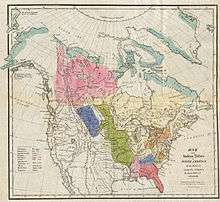
Gallatin moved to New York City in 1828 and became president of the National Bank of New York the following year. He attempted to persuade President Jackson to recharter the Second Bank of the United States, but Jackson vetoed a recharter bill and the Second Bank lost its federal charter in 1836. In 1831, Gallatin helped found New York University, and in 1843 he was elected president of the New–York Historical Society. In the mid-1840s, he opposed President James K. Polk's expansionist policies and wrote a widely-read pamphlet, Peace with Mexico, that called for an end to the Mexican–American War.[66]
Gallatin was deeply interested in Native Americans, and he favored their assimilation into European-American culture as an alternative to forced relocation.[67] He drew upon government contacts to research Native Americans, gathering information through Lewis Cass, explorer William Clark, and Thomas McKenney of the Bureau of Indian Affairs. Gallatin developed a personal relationship with Cherokee tribal leader John Ridge, who provided him with information on the vocabulary and the structure of the Cherokee language. Gallatin's research resulted in two published works: A Table of Indian Languages of the United States (1826) and Synopsis of the Indian Tribes of North America (1836). His research led him to conclude that the natives of North and South America were linguistically and culturally related and that their common ancestors had migrated from Asia in prehistoric times. Later research efforts include examination of selected Pueblo societies, the Akimel O'odham (Pima) peoples, and the Maricopa of the Southwest. In 1843, he co-founded the American Ethnological Society, serving as the society's first president.[67] Due to his studies of the languages of the Native Americans, he has been called "the father of American ethnology."[68]
The health of both Gallatin and his wife declined in the late 1840s, and Hannah died in May 1849.[69] On August 12, 1849, Gallatin died in Astoria, now in the Borough of Queens, New York at age 88. He is interred at Trinity Churchyard in New York City.[70] Prior to his death, Gallatin had been the last surviving member of the Jefferson cabinet and the last surviving senator from the 18th century.
Legacy
Gallatin is commemorated in the naming of a number of counties, roads, and streets, as well as through his association with New York University. The Gallatin River, named by the Lewis and Clark expedition, is one of three rivers (along with the Jefferson River and the Madison River) that converge near Three Forks, Montana to form the Missouri River. The town of Three Forks is in Gallatin County, Montana, and Montana also hosts Gallatin National Forest and Gallatin Range.[71] Gallatin, Tennessee, the seat of Sumner County and Gallatin County, Kentucky are also named for Gallatin. Gallatin's home of Friendship Hill is maintained by the National Park Service. A statue of Gallatin stands at the northern entrance of the Treasury Building; a statue of Hamilton stands at the building's southern entrance. The Albert Gallatin Area School District, located in south western Fayette County, Pennsylvania, and having contained within Gallatin's home, Friendship Hill, is also named after Gallatin.
Gallatin's name is associated with NYU's Gallatin School of Individualized Study.[72]
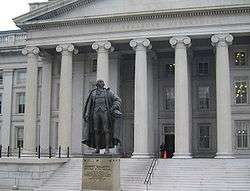 Statue of Albert Gallatin in front of the northern entrance to the United States Treasury Building
Statue of Albert Gallatin in front of the northern entrance to the United States Treasury Building- Albert Gallatin House; Friendship Hill National Historic Site
See also
- Friendship Hill National Historic Site
- Gallatin Bank Building
- List of foreign-born United States Cabinet Secretaries
- List of United States Senators born outside the United States
- Seconds pendulum
Citations
- To James Madison from William Jones, 14 January 1813
- How Britain Won the War of 1812: The Royal Navy's Blockades of the United States, 1812–1815
- Nicholas Dungan Gallatin: America's Swiss Founding Father (New York University Press, 2010)
- "Albert Gallatin". National Park Service. Retrieved August 31, 2018.
- Albert de Gallatin, and Gallatin (family) in the Historical Dictionary of Switzerland.
- Stevens (1888), p. 1
- Stevens (1888), p. 2.
- McGraw (2012), pp. 180–182
- Adams (1879), p. 16
- Stevens (1888), pp. 11–12.
- Stevens (1888), p16.
- McGraw (2012), pp. 184–185
- McGraw (2012), pp. 186–189
- McGraw (2012), pp. 190–192
- Albert de Gallatin, in the Historical Dictionary of Switzerland
- McGraw (2012), pp. 193–194
- McGraw (2012), pp. 199–200
- McGraw (2012), pp. 201–202
- McGraw (2012), pp. 192–193
- McGraw (2012), pp. 195–196
- McGraw (2012), pp. 198, 200–201
- Butler, Anne M.; Wolff, Wendy (1995). "Case 1: Albert Gallatin". Senate Election, Expulsion and Censure Cases from 1793 to 1990. Washington, D.C.: Government Printing Office. pp. 3–5.
- McGraw (2012), pp. 196–198
- McGraw (2012), pp. 202–203
- Rothman (1972), pp. 125–126
- McGraw (2012), p. 203
- McGraw (2012), pp. 204–206
- Furlong (1968), pp. 587–588, 597
- McGraw (2012), pp. 215–216
- McGraw (2012), pp. 217–219
- McGraw (2012), pp. 224–225
- McGraw (2012), pp. 227–228
- McGraw (2012), pp. 228–230
- McGraw (2012), pp. 266–267
- McGraw (2012), pp. 233–234
- McGraw (2012), pp. 211–212, 231–232
- McGraw (2012), pp. 233, 238
- Edwin G. Burrows. "Gallatin, Albert" in American National Biography Online (2000) Accessed Dec 03 2013
- McGraw (2012), pp. 232–233
- McGraw (2012), pp. 235–236
- McGraw (2012), pp. 238–243
- McGraw (2012), pp. 250–252
- McGraw (2012), pp. 253–257
- Carter Goodrich, "The Gallatin Plan after One Hundred and Fifty Years." Proceedings of the American Philosophical Society 1958 102(5): 436–41.
- McGraw (2012), pp. 271–273
- McGraw (2012), pp. 274–278
- McGraw (2012), pp. 281–282
- McGraw (2012), pp. 285–287
- McGraw (2012), pp. 261–263
- McGraw (2012), pp. 290–297
- McGraw (2012), pp. 287–289
- McGraw (2012), pp. 298–299
- McGraw (2012), pp. 299–302
- McGraw (2012), pp. 306–309
- McGraw (2012), pp. 309–314
- Adams (1879) p. 546
- McGraw (2012), pp. 312–313
- McGraw (2012), p. 315
- McGraw (2012), pp. 315–316
- "Rush-Bagot Pact, 1817 and Convention of 1818". Office of the Historian. United States Department of State. Retrieved August 31, 2018.
- Brown (1925), pp. 395–396
- Raymond Walters (1957), pp. 320–324
- Adams (1879), p. 599.
- Brown (1925), p. 401
- McGraw (2012), pp. 317–318
- McGraw (2012), pp. 318–323
- McGraw (2012), p. 322
- Dungan, p. 165
- McGraw (2012), p. 324
- "GALLATIN, Albert, (1761 - 1849)". Biographical Directory of the United States Congress. Retrieved August 31, 2018.
- McGraw (2012), p. 243
- Flanagin, Jake (August 21, 2013). "The Expensive Romance of NYU". The Atlantic. Retrieved April 18, 2020.
Works cited
- Adams, Henry (1879). Life of Albert Gallatin. J.B. Lippincott & Co. online edition
- Brown, Everett S. (1925). "The Presidential Election of 1824–1825". Political Science Quarterly. 40 (3): 384–403. doi:10.2307/2142211. JSTOR 2142211.
- Burrows, Edwin G. (2000). "Gallatin, Albert". American National Biography. Oxford University Press. doi:10.1093/anb/9780198606697.001.0001 (inactive January 22, 2020). Retrieved August 31, 2018.
- Dungan, Nicholas (2010). Gallatin: America's Swiss Founding Father. New York University Press. ISBN 978-0814721117.
- Furlong, Patrick J. (1968). "The Origins of the House Committee of Ways and Means". The William and Mary Quarterly. 25 (4): 587–604. doi:10.2307/1916799. JSTOR 1916799.
- Goodrich, Carter (1958). "The Gallatin Plan after One Hundred and Fifty Years". Proceedings of the American Philosophical Society. 102 (5): 436–441. JSTOR 985588.
- McGraw, Thomas K. (2012). The Founders and Finance: How Hamilton, Gallatin, and Other Immigrants Forged a New Economy. Belknap Press. ISBN 9780674066922.
- Mannix, Richard (1979). "Gallatin, Jefferson, and the Embargo of 1808". Diplomatic History. 3 (2): 151–172. doi:10.1111/j.1467-7709.1979.tb00307.x. ISSN 0145-2096.
- Rothman, Rozann (1972). "Political Method in the Federal System: Albert Gallatin's Contribution". Publius. 1 (2): 123–141. doi:10.1093/oxfordjournals.pubjof.a037841. JSTOR 3329473.
- Stevens, John Austin (1888). Albert Gallatin (6 ed.). Boston: Houghton Mifflin. OCLC 7327639.
- Walters, Raymond Jr. (1957). Albert Gallatin: Jeffersonian Financier and Diplomat. Macmillan. ISBN 978-0822952107. online edition
Further reading
Secondary sources
- Balinsky, Alexander S. (1958). "Albert Gallatin, Naval Foe". 82 (3). The Pennsylvania Magazine of History and Biography: 293–304. Cite journal requires
|journal=(help) - Cachia-Riedl, Markus Claudius (1998). Albert Gallatin and the Politics of the New Nation. Ph.D. dissertation at U. of California, Berkeley. UMI Dissertation Services. OCLC 427962570.
- Heinlein, Jay C. (1950). "Albert Gallatin: A Pioneer in Public Administration". The William and Mary Quarterly. 7 (1): 64–94. doi:10.2307/1922937. JSTOR 1922937.
- Hickey, Donald R. (1981). "American Trade Restrictions during the War of 1812". Journal of American History. 68 (3): 517–538. doi:10.2307/1901937. JSTOR 1901937.
- Kuppenheimer, L. B. (1996). Albert Gallatin's Vision of Democratic Stability: An Interpretive Profile. Praeger. ISBN 978-0275953881.
- May, Gregory (2018). Jefferson's Treasure: How Albert Gallatin Saved the New Nation from Debt. Regnery History. ISBN 978-1621576457.
- McDonald, Forrest (1976). The Presidency of Thomas Jefferson. University Press of Kansas. ISBN 978-0700603305.
- Nelson, John Robert (1979). Hamilton and Gallatin: Political Economy and Policy-Making in the New Nation, 1789–1812. Ph.D. dissertation, Northern Illinois U.
- Nettels, Curtis (1962). The Emergence of a National Economy, 1775–1815. Holt, Rinehart & Winston. ASIN B07219JL61.
- Rutland, Robert A. (1990). The Presidency of James Madison. University Press of Kansas. ISBN 978-0700604654.
Primary sources
- Adams, Henry, ed. (1879). The Writings of Albert Gallatin. Three volumes. Philadelphia, J.B. Lippincott. Volume I (PDF), Volume II (PDF),Volume III (PDF)
- Gallatin, Albert (1976). "The Land West of the Rockies". The Annals of America. 11 volumes. Chicago: Encyclopædia Britannica. pp. 209–214.
- Gallatin, Albert (1848). Peace with Mexico. Hosted by the Portal to Texas History.
- Gallatin, Albert (1836). "A Synopsis of the Indian Tribes Within the United States East of the Rocky Mountains, and in the British and Russian Possessions in North America". Zea E-Books in American Studies.
External links
| Wikimedia Commons has media related to Albert Gallatin. |
- . Encyclopædia Britannica (11th ed.). 1911.
- . Appletons' Cyclopædia of American Biography. 1900.
- Kestenbaum, Lawrence. "Index to Politicians: Gallaher to Gallmeyer". The Political Graveyard. Archived from the original on August 7, 2006. Retrieved August 22, 2006.
- United States Congress. "Albert Gallatin (id: G000020)". Biographical Directory of the United States Congress.
- Works by Albert Gallatin at Project Gutenberg
- Works by or about Albert Gallatin at Internet Archive
- Albert Gallatin, Secretary of Treasury & U.S. Congressman at Find a Grave
- Friendship Hill National Historical Site
- Albert Gallatin, A Genevan at the root source of the American dream. Exhibition, 14.10.2011–17.03.2012, Library of Genava, Switzerland
- Gallatin, Albert. "REPORT OF THE SECRETARY OF THE TREASURY ON THE SUBJECT OF PUBLIC ROADS AND CANALS". Retrieved May 25, 2018.
- Albert Gallatin's papers at the Indiana State Library
| U.S. Senate | ||
|---|---|---|
| Preceded by William Maclay |
United States Senator (Class 1) from Pennsylvania 1793–1794 Served alongside: Robert Morris |
Succeeded by James Ross |
| Honorary titles | ||
| Preceded by John Rutherfurd |
Baby of the Senate 1793–1794 |
Succeeded by John Rutherfurd |
| Most Senior Living U.S. Senator Sitting or Former 1840–1849 |
Succeeded by William Plumer | |
| U.S. House of Representatives | ||
| Preceded by William Findley |
Member of the U.S. House of Representatives from Pennsylvania's 12th congressional district 1795–1801 |
Succeeded by William Hoge |
| Political offices | ||
| Preceded by Samuel Dexter |
United States Secretary of the Treasury 1801–1814 |
Succeeded by George W. Campbell |
| Diplomatic posts | ||
| Preceded by William H. Crawford |
United States Minister to France 1816–1823 |
Succeeded by James Brown |
| Preceded by Rufus King |
United States Minister to the United Kingdom 1826–1827 |
Succeeded by James Barbour |
| Party political offices | ||
| Preceded by Daniel D. Tompkins |
Democratic-Republican nominee for Vice President of the United States¹ Withdrew 1824 Served alongside: John C. Calhoun, Nathan Sanford |
Succeeded by Nathaniel Macon |
| Notes and references | ||
| 1. The Democratic-Republican Party split in the 1824 election, fielding four separate candidates. | ||
.jpg)
